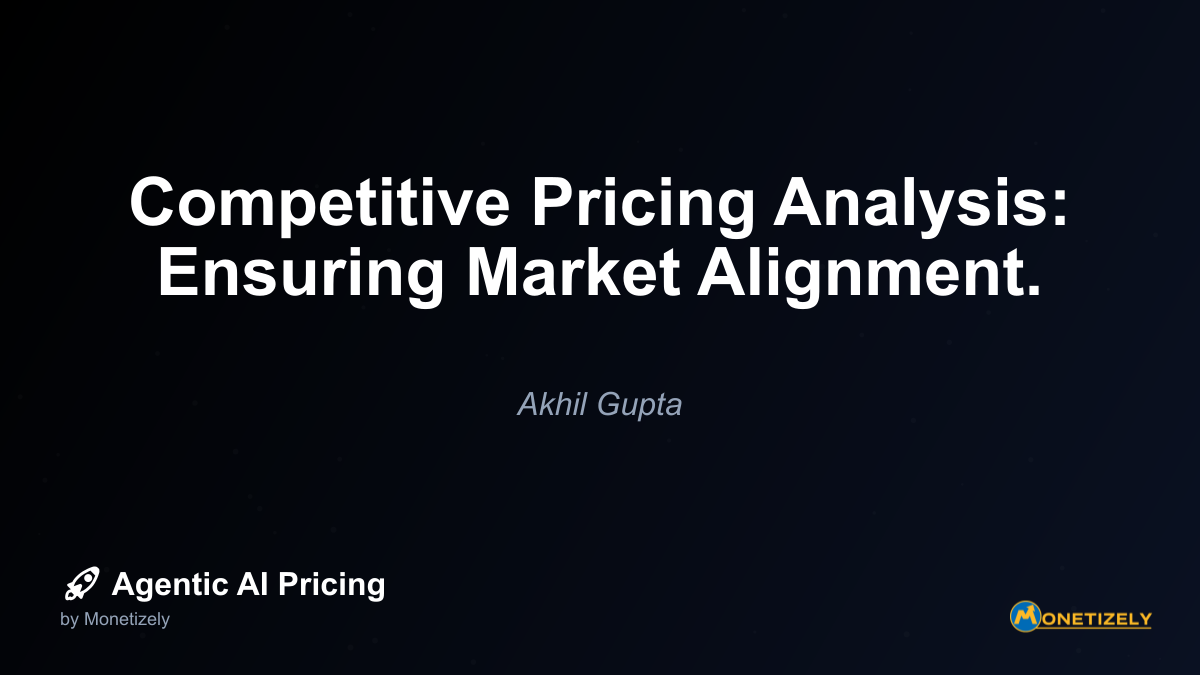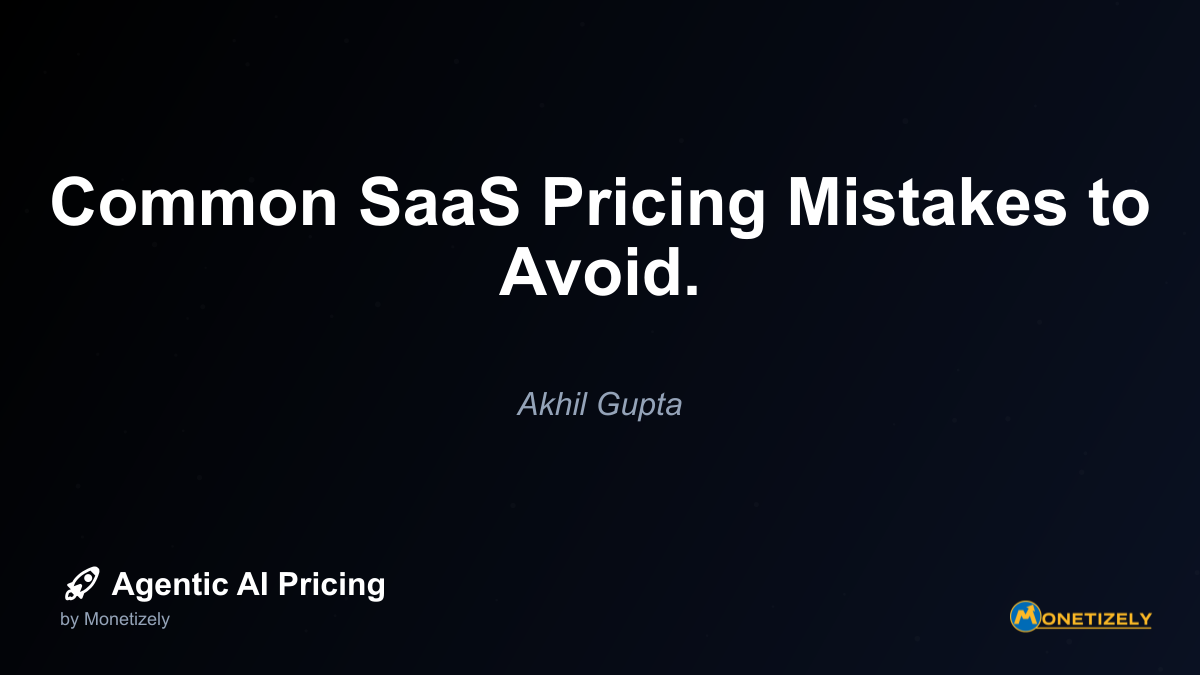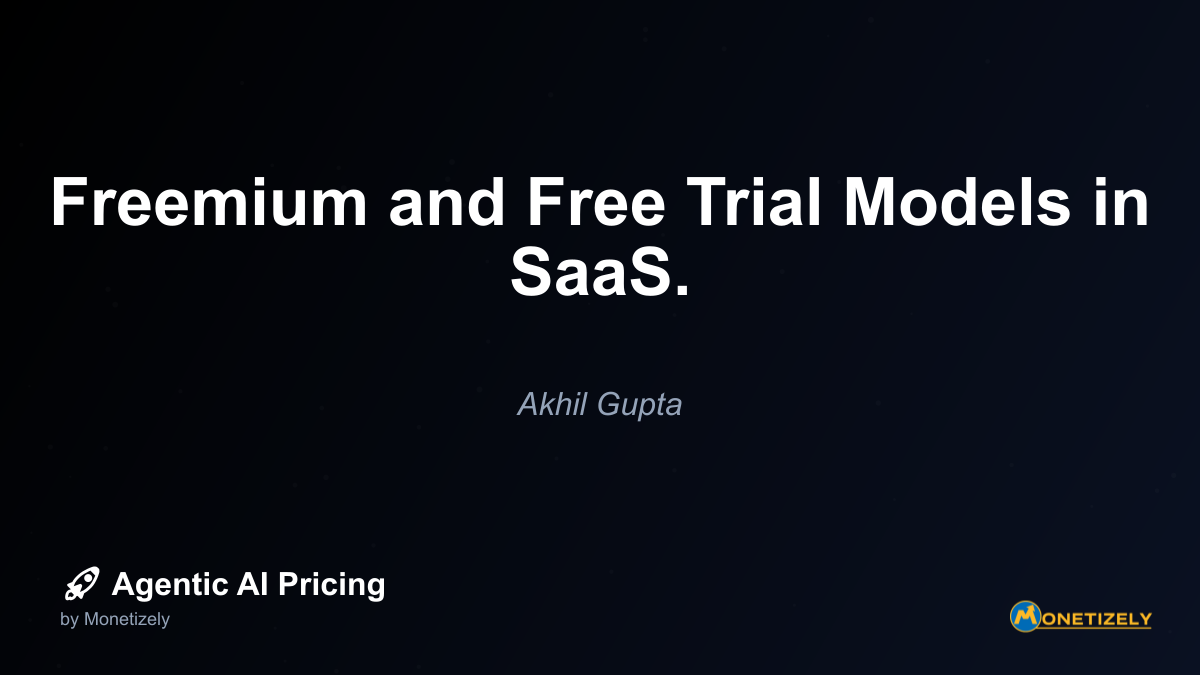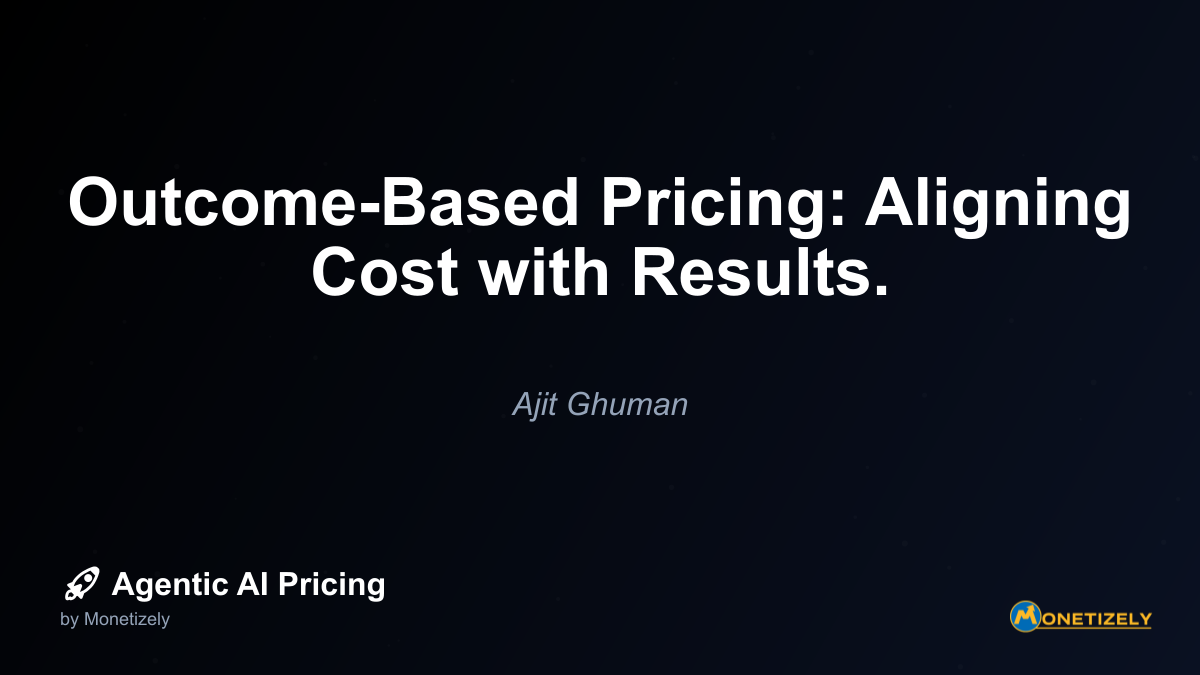· Akhil Gupta · Pricing Fundamentals · 11 min read
Competitive Pricing Analysis: Ensuring Market Alignment.
AI and SaaS Pricing Masterclass
Learn the art of strategic pricing directly from industry experts. Our comprehensive course provides frameworks and methodologies for optimizing your pricing strategy in the evolving AI landscape. Earn a professional certification that can be imported directly to your LinkedIn profile.

In today’s hyper-competitive business landscape, pricing decisions can make or break a company’s success. Yet many organizations still rely on gut feeling, arbitrary markups, or outdated models when determining their pricing strategy. Among the most critical components of effective pricing is competitive analysis - the systematic process of evaluating your competitors’ pricing structures to inform your own strategic decisions.
Competitive pricing analysis isn’t merely about matching or undercutting rivals. It’s about understanding the entire market landscape, identifying your unique position within it, and communicating value in ways that resonate with customers. This is especially true in emerging fields like agentic AI, where pricing models are still evolving and customer expectations remain fluid.
Why Competitive Pricing Analysis Matters
Competitive pricing analysis provides crucial market intelligence that helps businesses make informed decisions. Without a clear understanding of market dynamics, companies risk either leaving money on the table with unnecessarily low prices or pricing themselves out of consideration with rates that don’t align with perceived value.
For agentic AI solutions in particular, where the technology itself may be novel to many customers, competitive benchmarking helps establish reference points that make your offering more accessible and understandable. When customers can easily compare your solution against alternatives, they gain confidence in their purchasing decisions.
Beyond immediate revenue implications, competitive pricing analysis supports several strategic business objectives:
- Market positioning - Understanding where your offering sits relative to competitors helps define your market position
- Product development - Identifying feature-price relationships across competitors can guide R&D priorities
- Marketing messaging - Competitive insights inform how you communicate value differentiators
- Customer segmentation - Analysis reveals which market segments different competitors target effectively
- Long-term strategy - Tracking pricing trends over time provides early warning of market shifts
Organizations that regularly conduct competitive pricing analysis are better positioned to adapt to changing market conditions, respond to competitive threats, and capitalize on emerging opportunities.
How to Conduct Effective Competitive Pricing Analysis
Conducting thorough competitive analysis requires a structured approach. Here’s a step-by-step framework for implementing an effective competitive pricing analysis process:
1. Identify Your True Competitors
Not every company in your general space represents direct competition. Begin by categorizing potential competitors into three tiers:
Direct competitors: Companies targeting the same customer segments with similar solutions. These are your primary focus for pricing analysis.
Indirect competitors: Organizations solving the same customer problems with different approaches or technologies. These provide important context for value perception.
Aspirational competitors: Larger or more established companies you aim to compete with in the future. These offer insights into potential market evolution.
For agentic AI solutions, direct competitors might include other AI-powered tools with similar capabilities, while indirect competitors could include traditional software or even manual processes that address the same use cases.
When identifying competitors, look beyond the obvious. Consider:
- Companies mentioned in analyst reports
- Alternatives that appear in online searches
- Solutions that prospects mention during sales conversations
- Tools that existing customers use alongside yours
Create a comprehensive competitor list, then prioritize the most relevant ones for detailed analysis.
2. Gather Pricing and Packaging Information
Once you’ve identified key competitors, collect detailed information about their pricing structures and packaging approaches. This data gathering phase can be challenging, as not all competitors openly share complete pricing information.
Effective data sources include:
Public information:
- Company websites and pricing pages
- Published rate cards or service catalogs
- Case studies and press releases
- App marketplaces and platforms
Industry intelligence:
- Analyst reports and market studies
- Industry forums and communities
- Conference presentations
- Regulatory filings for public companies
Direct investigation:
- Mystery shopping and sales inquiries
- Free trials and demos
- Customer interviews (respecting confidentiality)
- Conversations with former employees (within ethical boundaries)
For each competitor, document:
- Base pricing and packaging tiers
- Feature availability across tiers
- Add-on and optional components
- Volume or usage-based pricing elements
- Discount structures and promotional offers
- Contract terms and minimum commitments
- Implementation and onboarding fees
Be thorough but ethical in your research. Avoid misrepresentation or requesting information under false pretenses.
3. Analyze Pricing Models and Structures
With competitor data collected, analyze how each company structures their pricing model. Look for patterns and variations in approaches such as:
Pricing methodologies:
- Subscription vs. one-time purchase
- Per-user vs. per-organization licensing
- Usage-based vs. flat-rate pricing
- Tiered vs. continuous pricing scales
- Freemium vs. paid-only models
Packaging strategies:
- Good-better-best tiering
- Feature-based segmentation
- Industry-specific packaging
- Role-based licensing options
- Platform vs. modular approaches
Revenue optimization techniques:
- Cross-selling and upselling paths
- Bundling strategies
- Price fencing mechanisms
- Seasonal or promotional pricing
- Loyalty and renewal incentives
For agentic AI solutions specifically, examine how competitors handle pricing for:
- API access and programmatic integration
- Processing capacity and computational resources
- Data storage and management
- Model customization and training
- Output quality and refinement options
Document these observations systematically, using consistent categories across all competitors to facilitate comparison.
4. Benchmark Feature-Price Relationships
Next, create a feature-price matrix that maps competitor offerings against their pricing. This reveals how different companies value specific capabilities and helps identify potential gaps in the market.
For each significant feature or capability:
- Note which competitors offer it
- Identify at which pricing tier it becomes available
- Calculate the effective price premium for access
- Assess whether it’s positioned as core or premium
This analysis often reveals strategic differences in how competitors view their market:
- Some position advanced features as premium upsells
- Others include powerful capabilities in base tiers to drive adoption
- Some bundle features comprehensively
- Others offer more à la carte flexibility
Pay special attention to how competitors handle emerging capabilities. In agentic AI, for example, features like custom model fine-tuning, specialized vertical models, or enhanced security protocols might be priced differently across competitors as the market evolves.
5. Evaluate Value Communication
Beyond raw pricing data, analyze how competitors communicate their value proposition. This qualitative assessment provides crucial context for pricing differentials.
Examine:
- Key messaging themes and value claims
- Primary benefits highlighted in marketing
- Customer testimonials and case studies
- ROI calculations and value justifications
- Competitive differentiators emphasized
This analysis helps identify whether price differences reflect actual value differences or simply communication gaps. A competitor charging premium prices may justify this through superior value articulation rather than superior capabilities.
For agentic AI solutions, pay particular attention to how competitors communicate:
- Performance advantages (speed, accuracy, reliability)
- Integration capabilities and ecosystem connections
- Data security and compliance frameworks
- Implementation support and customer success
- Innovation roadmap and future-proofing
These value elements often justify significant price premiums in emerging technology categories.
6. Map Customer Segments and Targeting
Different competitors often target different customer segments within the broader market. Understanding these targeting strategies provides essential context for pricing comparisons.
For each competitor, identify:
- Primary industry verticals targeted
- Company size focus (enterprise, mid-market, SMB)
- Geographic targeting and regional pricing
- Role-based positioning (technical vs. business users)
- Use case specialization and niche focus
This segmentation analysis often reveals that apparent pricing discrepancies actually reflect different target audiences. A competitor offering similar capabilities at a lower price may be targeting smaller organizations with different implementation needs and value expectations.
In the agentic AI space, segmentation is particularly important as the technology finds applications across diverse industries and use cases. Some competitors may focus on specific vertical applications (e.g., healthcare, finance, legal) with pricing optimized for those contexts, while others pursue horizontal capabilities with more generalized pricing.
Applying Competitive Insights to Your Pricing Strategy
Gathering competitive intelligence is only valuable if it informs strategic action. Here’s how to translate your analysis into actionable pricing decisions:
1. Identify Your Unique Position
Based on competitive analysis, determine your optimal market position. Options include:
Premium positioning: Charging higher prices justified by superior capabilities, service levels, or specialized expertise. This approach requires clear value differentiation and strong brand positioning.
Value positioning: Offering competitive capabilities at mid-market prices, emphasizing overall value rather than being the cheapest or most feature-rich option.
Penetration pricing: Setting lower initial prices to build market share and customer base, particularly effective in emerging markets where establishing a foothold is crucial.
Niche specialization: Focusing on specific customer segments with tailored offerings that command segment-specific pricing, potentially higher than generalist alternatives.
For agentic AI solutions, your positioning should reflect both current market realities and your long-term strategic vision. If your technology offers genuine innovation, premium pricing may be justified despite competitive pressure.
2. Design Pricing Tiers and Structures
Use competitive benchmarks to inform your pricing structure design:
- Tier definition: Establish entry, mid-market, and premium tiers aligned with competitive offerings but differentiated through your unique capabilities
- Feature allocation: Strategically place features across tiers based on competitive norms and your differentiation strategy
- Pricing mechanics: Select pricing units (per user, per usage, etc.) that align with customer value perception and competitive expectations
- Upsell paths: Design clear upgrade pathways that encourage customer expansion
When designing tiers, balance competitive alignment with strategic differentiation. Don’t simply mirror competitor approaches - use competitive insights to inform a structure that highlights your unique strengths.
3. Set Price Points Strategically
With positioning and structure defined, establish specific price points that reflect both competitive reality and your value proposition:
- Reference pricing: Use competitor benchmarks as reference points, not absolute constraints
- Value-based adjustments: Adjust relative to competitors based on your differentiated value
- Strategic premiums/discounts: Apply premiums where you excel and potential discounts where competitors have advantages
- Psychological pricing: Consider pricing psychology (e.g., charm pricing) within competitive contexts
The goal isn’t necessarily to be cheaper than competitors. Rather, it’s to ensure your pricing aligns with the relative value you deliver compared to alternatives.
4. Develop Competitive Response Plans
Prepare for competitive pricing actions with scenario-based response plans:
- Price decrease scenarios: Define how you’ll respond to competitor price cuts across different segments
- New entrant scenarios: Establish guidelines for addressing new market entrants with disruptive pricing
- Premium challenger scenarios: Prepare responses for competitors attempting to leapfrog your capabilities with premium offerings
- Bundling scenarios: Develop strategies for addressing competitive bundling that changes effective pricing
These response plans should balance short-term competitive positioning with long-term pricing integrity. Avoid reactive price changes that damage profitability without delivering sustainable competitive advantage.
Communicating Your Value Difference
Competitive pricing isn’t just about setting prices - it’s about effectively communicating why your pricing reflects your unique value. Based on competitive analysis, develop messaging that clearly articulates your value proposition:
1. Highlight Unique Capabilities
Identify and emphasize capabilities that competitors don’t offer or don’t execute as well. These differentiators justify pricing premiums and shift customer focus from direct price comparisons to value evaluation.
For agentic AI solutions, potential differentiators might include:
- Proprietary algorithms or models with superior performance
- Unique data sources or training methodologies
- Specialized industry knowledge embedded in solutions
- Superior integration capabilities or ecosystem connections
- More transparent or explainable AI approaches
Feature comparison charts can effectively highlight these differences, but ensure they emphasize meaningful value distinctions rather than technical specifications that customers may not fully appreciate.
2. Quantify Value Impact
Whenever possible, translate your differentiators into quantifiable customer outcomes:
- Productivity improvements (time saved, output increased)
- Cost reductions (resource efficiency, error prevention)
- Revenue enhancement (conversion improvements, expansion opportunities)
- Risk mitigation (compliance assurance, security enhancements)
- Strategic advantages (faster time-to-market, competitive intelligence)
These quantified impact statements help customers contextualize price differences. A solution that costs 20% more but delivers 40% greater productivity represents clear value despite the premium.
3. Develop Competitive Battlecards
Equip your sales team with competitive battlecards that address pricing objections directly:
- Common competitor comparisons with prepared responses
- Feature-by-feature value comparisons with competitive context
- Total cost of ownership calculations across typical scenarios
- Customer success stories that demonstrate superior ROI
- Specific handling guidance for price-focused negotiations
These resources ensure your team can confidently address competitive pricing questions without unnecessary discounting or value concessions.
4. Create Comparison Content
Develop marketing content that proactively addresses competitive comparisons:
- Comparison guides that highlight your advantages
- ROI calculators that demonstrate value over time
- Case studies featuring customers who switched from competitors
- Analyst perspectives on market positioning and value differentiation
- Educational content on “how to evaluate” solutions in your category
This content helps shape evaluation criteria in your favor and ensures price is contextualized within broader value considerations.
Maintaining Competitive Alignment Over Time
Competitive pricing analysis isn’t a one-time exercise. Markets evolve, competitors adjust strategies, and customer expectations shift. Implement these practices to maintain competitive alignment:
1. Establish Regular Review Cadence
Schedule systematic competitive reviews:
- Quarterly deep-dive analysis of primary competitors
- Monthly monitoring of pricing changes and promotions
- Annual comprehensive market landscape assessment
- Event-triggered reviews when significant market changes occur
These regular reviews ensure you maintain market awareness without becoming reactively focused on competitors.
2. Monitor Pricing Signals
Develop systems to capture competitive pricing signals:
- Sales team competitive encounter reporting
- Win/loss analysis with pricing focus
- Customer and prospect feedback mechanisms
- Automated monitoring of competitor websites and communications
- Industry analyst relationships and information sharing
These signals provide early warning of competitive pricing shifts before they become widely established in the market.
3. Balance Stability and Responsiveness
When responding to competitive changes, balance pricing stability with market responsiveness:
- Avoid reactive price changes for minor competitive adjustments
- Respond strategically to significant competitive repositioning
- Consider non-price responses (feature enhancements, service improvements) before price changes
- Communicate pricing changes clearly with value-based justification
This balanced approach maintains pricing integrity while ensuring you remain competitively positioned.
Conclusion: Beyond Price Matching
Effective competitive pricing analysis goes far beyond simply matching or beating competitor prices. It’s about understanding the complete competitive landscape, identifying your unique position within it, and communicating value in ways that justify your chosen price points.
For agentic AI solutions in particular, where the technology itself continues to evolve rapidly, competitive pricing requires both market awareness and strategic vision. Today’s pricing decisions must reflect current competitive realities while positioning your offering for future market evolution.
By implementing a structured approach to competitive analysis, you can develop pricing strategies that balance competitive alignment with value differentiation. This balanced approach ensures your pricing supports both customer acquisition and sustainable profitability.
Remember that pricing is ultimately about value exchange, not just numbers on a page. The most successful pricing strategies emerge when companies deeply understand both their competitive landscape and their unique value contribution, then align their pricing to reflect that distinctive position in the market.
Co-Founder & COO
Akhil is an Engineering leader with over 16+ years of experience in building, managing and scaling web-scale, high throughput enterprise applications and teams. He has worked with and led technology teams at FabAlley, BuildSupply and Healthians. He is a graduate from Delhi College of Engineering and UC Berkeley certified CTO.
Pricing Strategy Audit
Let our experts analyze your current pricing strategy and identify opportunities for improvement. Our data-driven assessment will help you unlock untapped revenue potential and optimize your AI pricing approach.




